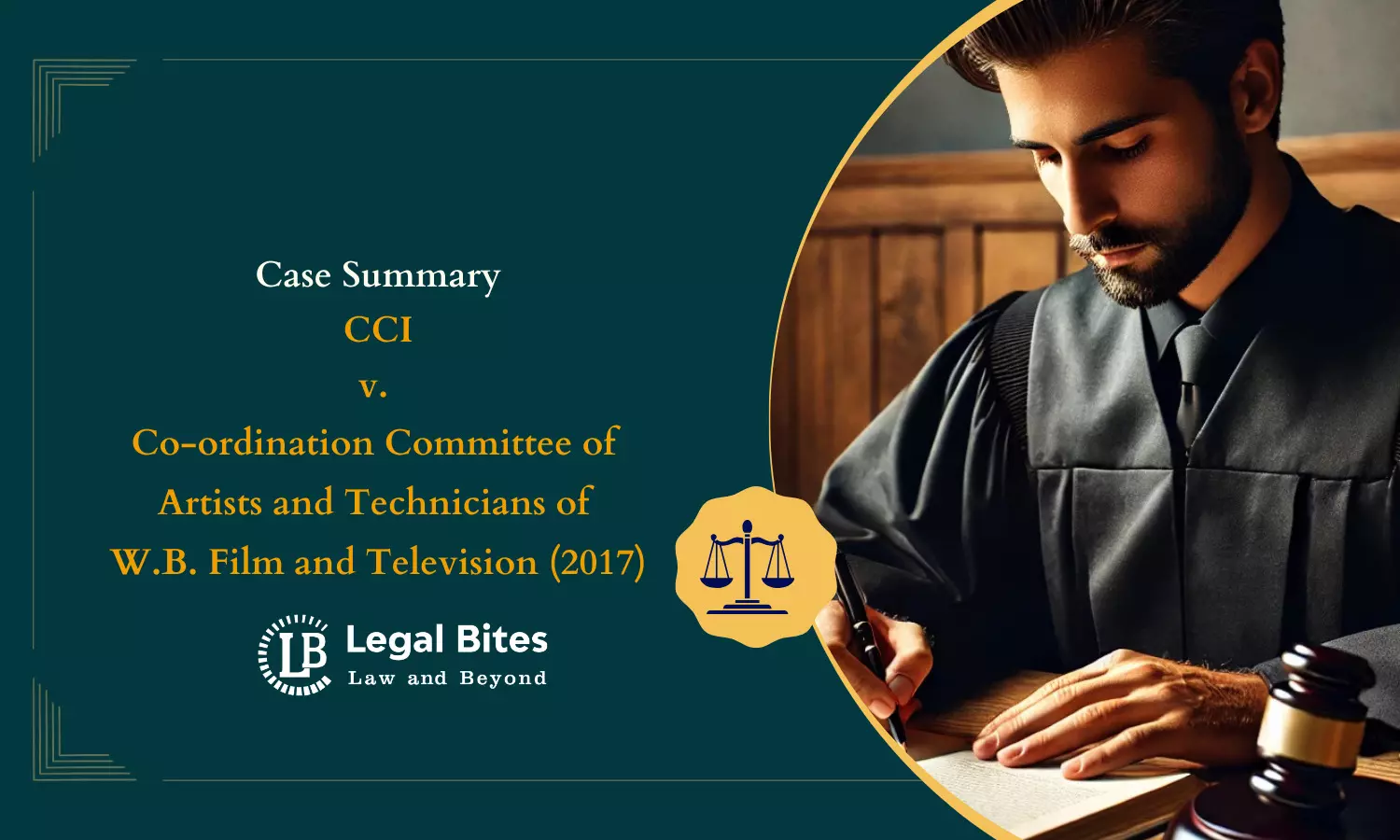Case Summary: CCI v. Co-ordination Committee of Artists and Technicians of W.B. Film and Television (2017) | Anti-Competitive Agreements
This case examines anti-competitive practices by the Co-ordination Committee of Artists & Technicians of W.B. Film under the Competition Act, 2002.

This case addressed a significant issue concerning the scope of the Competition Commission of India's jurisdiction under Section 3 of the Competition Act, 2002. The central question was whether acts of trade associations that restrain the telecast of dubbed television content could be considered anti-competitive agreements affecting competition in the relevant market.The Supreme Court's ruling is a landmark in understanding how trade union-like entities, when acting in concert with...
This case addressed a significant issue concerning the scope of the Competition Commission of India's jurisdiction under Section 3 of the Competition Act, 2002. The central question was whether acts of trade associations that restrain the telecast of dubbed television content could be considered anti-competitive agreements affecting competition in the relevant market.
The Supreme Court's ruling is a landmark in understanding how trade union-like entities, when acting in concert with industry players, may fall within the ambit of anti-competitive practices under the Competition Act.
Case Title: Competition Commission of India (CCI) v. Co-ordination Committee of Artists and Technicians of W.B. Film and Television
Citation: AIR 2017 SC 1449; (2017) 5 SCC 17
Court: Supreme Court of India
Bench: A.K. Sikri and Abhay Manohar Sapre, JJ.
Date of Judgment: 7 March 2017
Background and Facts
Respondent No. 2, Mr. Sajjan Kumar Khaitan, proprietor of Hart Video, Kolkata, engaged in the business of distributing regional TV serials, obtained sub-rights for dubbing the Hindi serial Mahabharat into Bangla. With the necessary agreements in place, the serial was to be telecast on two regional channels—Channel 10 and CTVN+.
However, trade associations in the region, specifically:
- Eastern India Motion Picture Association (EIMPA), and
- Co-ordination Committee of Artists and Technicians of West Bengal Film and Television (Coordination Committee),
objected to the telecast of dubbed content, alleging it would adversely affect the Bengali film and TV industry and the employment of local artists and technicians.
They issued threatening letters to the channels demanding the stoppage of the telecast. At the same time, CTVN+ continued to broadcast, and Channel 10 discontinued airing the dubbed serial under pressure. This prompted Mr. Khaitan to file a complaint with the Competition Commission of India (CCI).
Proceedings Before the CCI
The CCI formed a prima facie opinion that the actions of EIMPA and the Coordination Committee were anti-competitive. The matter was referred to the Director General (DG) for detailed investigation under the Competition Act, 2002.
DG’s Findings:
- The Coordination Committee and EIMPA, through threats and coercion, restricted the telecast of the dubbed serial.
- The conduct amounted to controlling and limiting the supply of dubbed content in the regional market.
- This, according to the DG, constituted a horizontal agreement under Section 3(3)(b) of the Act, leading to an appreciable adverse effect on competition (AAEC).
- The relevant market was identified as the film and television industry of West Bengal.
Arguments by the Coordination Committee and EIMPA
The Coordination Committee challenged the jurisdiction of the CCI and DG, asserting:
- Trade Union Exemption: It was a registered trade union under the Trade Unions Act, 1926, and not an enterprise engaged in production or distribution.
- No Economic Activity: The Coordination Committee did not engage in economic activities, and its actions were like a legitimate protest under Article 19(1)(a) of the Constitution.
- Different Market: It did not operate in the same relevant market as the broadcasters and therefore, there was no anti-competitive agreement.
Decision by the CCI
Majority Opinion:
- Found that both EIMPA and the Coordination Committee had acted in concert to restrict the broadcast of dubbed serials, constituting an anti-competitive agreement.
- These bodies, although trade unions, acted on behalf of their constituent members, many of whom were directly involved in production, distribution, and exhibition—economic activities falling within the Competition Act.
- Held that the action foreclosed competition and limited the market, thus violating Section 3(3)(b) of the Act.
- Defined the relevant market as the film and television industry in West Bengal, given the broad impact of the boycott.
Dissenting Opinion:
- One judicial member disagreed, asserting the relevant market was limited to the telecast of TV serials, not the whole film and television industry.
- Emphasised that trade union activity, even if coercive, did not amount to an anti-competitive agreement unless the union was operating in the same market.
- Asserted the right to protest under Article 19(1)(a) and found no economic nexus with the affected market.
- Appeal to the Competition Appellate Tribunal (COMPAT)
- Only the Coordination Committee appealed (EIMPA accepted the CCI’s ruling). The COMPAT reversed the CCI’s majority decision, holding:
- The relevant market was wrongly identified; it should have been limited to the broadcast of TV serials.
- The Coordination Committee was not an enterprise and did not operate in the same market.
- There was no anti-competitive agreement as required under Section 3(3)(b).
- The act was a form of trade union protest, protected under the Constitution, and not a competition law issue.
Supreme Court’s Judgment
The Supreme Court allowed the appeal filed by the Competition Commission of India, reversing the COMPAT’s decision and reinstating the CCI’s majority view.
Key Issues Addressed:
1. What is the Relevant Market?
- The Court held that the relevant market was not just the broadcasting of the serial, but the entire film and television industry in West Bengal.
- The intent and impact of the boycott extended beyond a single telecast, targeting the broader industry and seeking to prevent dubbed content from entering the regional space.
- The Coordination Committee’s letters revealed a broader concern to “protect the Bengali TV and Film Industry.”
- Therefore, the film and TV industry in West Bengal was rightly identified as the relevant market.
2. Whether the Conduct was Anti-Competitive under Section 3?
- The Court observed that although the Coordination Committee was a trade union, it was also acting as an association of enterprises/persons involved in production and distribution.
- The definition of “agreement” under Section 2(b) was broad enough to include informal, unwritten concerted actions, such as the coercive campaign run by the Coordination Committee.
- The trade union guise did not protect the Coordination Committee from scrutiny under the Competition Act when acting in the economic interest of its constituent enterprises.
- The collective action of writing threatening letters, calling for boycotts, and staging protests had the effect of restricting supply and creating barriers for new entrants, as per Section 19(3)(a)-(c).
- Thus, the action fell under the prohibited agreements under Section 3(3)(b).
Observations by the Supreme Court
- The Court reiterated that the Competition Act, 2002 is designed to ensure free and fair competition in India’s markets.
- Protectionist behaviour, even if well-intended (such as preserving regional industry), is not a valid excuse for anti-competitive conduct.
- The Act frowns upon collective boycotts and market manipulation, especially when carried out by associations representing economic actors.
- The right to protest under Article 19(1)(a) does not override the Competition Act when such a protest seeks to restrict market access or distort competition.
Conclusion
- The Supreme Court upheld the original finding of the CCI that the Co-ordination Committee’s actions constituted an anti-competitive agreement under Section 3(3)(b) of the Competition Act. The judgment clarified that:
- Trade associations or collectives of economic actors, even if operating under a trade union structure, cannot shield themselves from competition scrutiny when they affect market dynamics.
- The notion of relevant market must consider the wider economic effect, not just the immediate act (such as a TV telecast).
- Concerted action that limits supply, restricts new content, or threatens economic retaliation is anti-competitive under the Act.
- The appeal was allowed, and the Coordination Committee’s actions were declared in violation of the Competition Act, 2002.
Significance
This judgment is a landmark in Indian competition law, particularly for:
- Expanding the scope of what constitutes an “agreement” under Section 3.
- Holding trade unions and associations accountable when they act in economic spheres.
- Affirming that constitutional rights cannot be misused to engage in cartel-like behaviour.
- Strengthening the enforcement capability of the CCI in curbing regional and protectionist market barriers.
Click Here to Read the Official Judgment

Avan Patil
Avan is an alumnus of the Faculty of Law, Aligarh Muslim University, where he earned his Bachelor’s degree in Law. He further honed his expertise by completing an LLM in Corporate Law at the University of Edinburgh. With a deep passion for research and writing, his work primarily revolves around corporate governance, mergers & acquisitions, and regulatory frameworks, aiming to contribute to the evolving corporate legal landscape.
